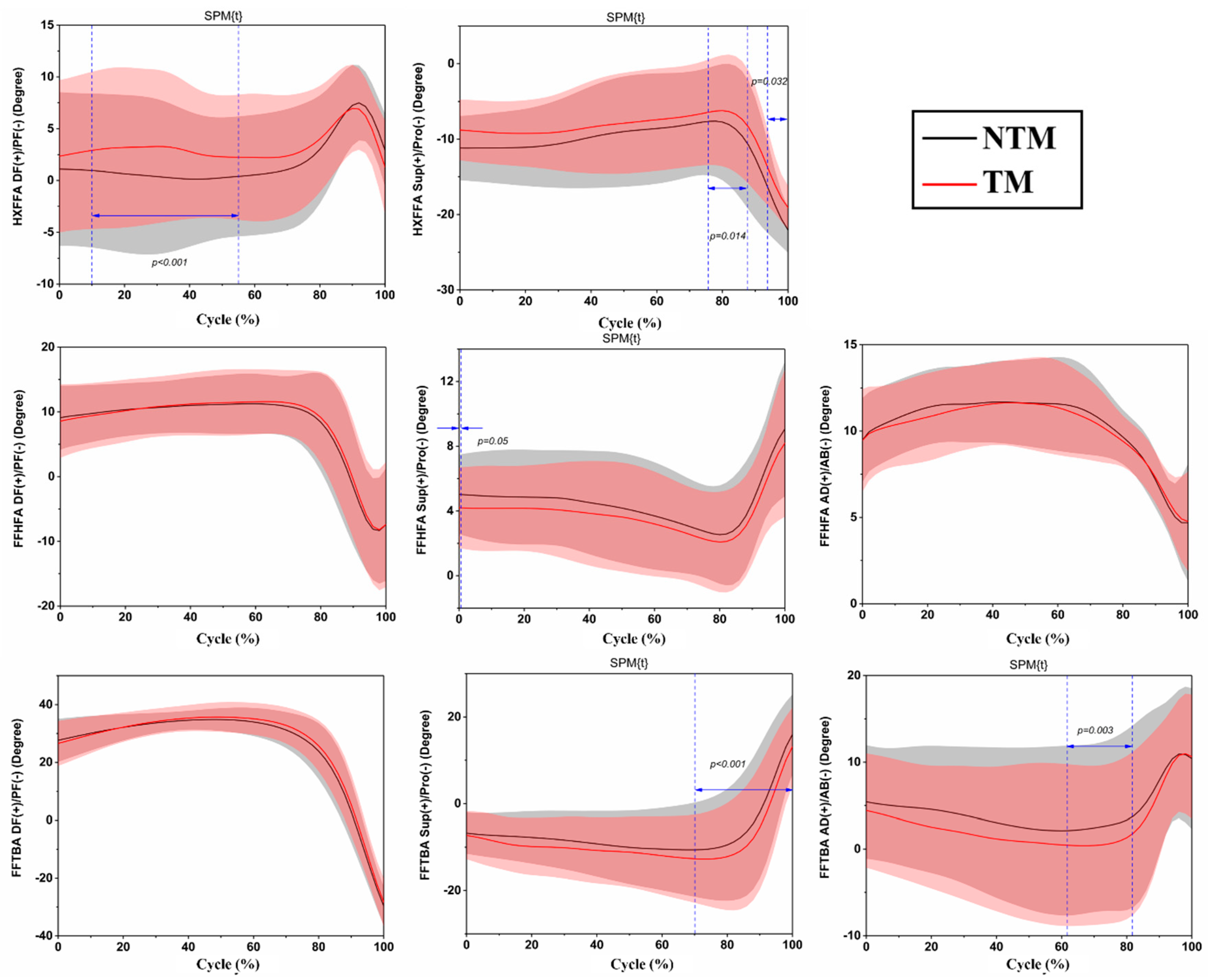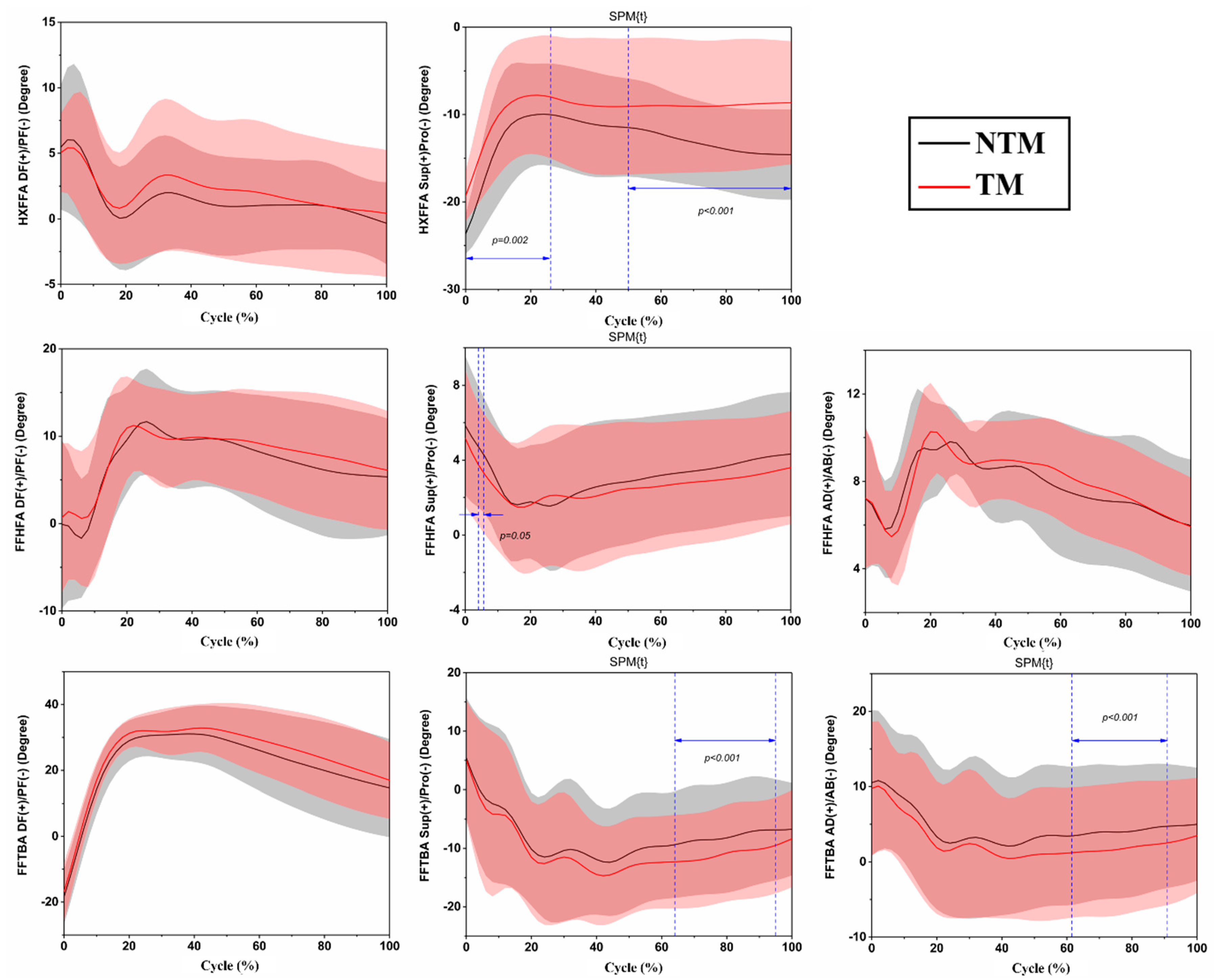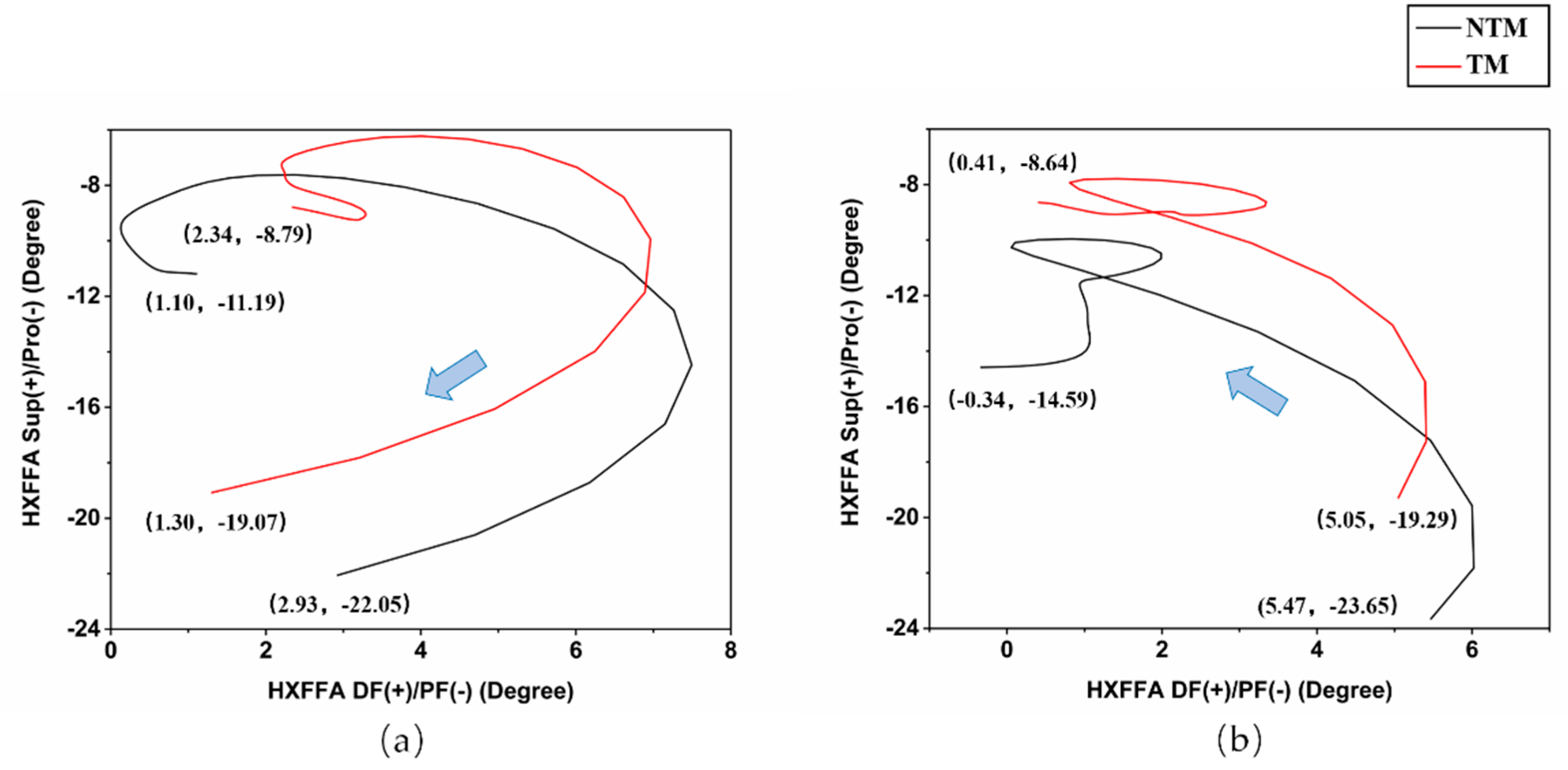Multi-Segmental Motion in Foot during Counter-Movement Jump with Toe Manipulation
Abstract
1. Introduction
2. Materials and Methods
2.1. Subjects
2.2. Experimental Protocol and Procedure
2.3. Data Collection and Statistical Analysis
3. Results
3.1. Take-Off Phase
3.1.1. Plantar Pressure Distribution
3.1.2. Foot Inter-Segment Kinematics
3.2. Landing Phase
3.2.1. Plantar Pressure Distribution
3.2.2. Foot Inter-Segment Kinematics
4. Discussion
5. Conclusions
Author Contributions
Funding
Conflicts of Interest
References
- Shu, Y.; Mei, Q.; Fernandez, J.; Li, Z.; Feng, N.; Gu, Y. Foot Morphological Difference between Habitually Shod and Unshod Runners. PLoS ONE 2015, 10, e0131385. [Google Scholar] [CrossRef] [PubMed]
- Kadambande, S.; Khurana, A.; Debnath, U.; Bansal, M.; Hariharan, K. Comparative anthropometric analysis of shod and unshod feet. Foot 2006, 16, 188–191. [Google Scholar] [CrossRef]
- Jiang, C. The effect of basketball shoe collar on ankle stability: a systematic review and meta-analysis. Phys. Act. Health 2020, 4, 11–18. [Google Scholar] [CrossRef][Green Version]
- Shu, Y.; Zhang, Y.; Fu, L.; Fekete, G.; Baker, J.S.; Li, J.; Gu, Y. Dynamic loading and kinematics analysis of vertical jump based on different forefoot morphology. SpringerPlus 2016, 5, 1999. [Google Scholar] [CrossRef]
- Lambrinudi, C. Use and Abuse of Toes. Postgrad. Med. J. 1932, 8, 459–464. [Google Scholar] [CrossRef][Green Version]
- Xiang, L.; Mei, Q.; Fernandez, J.; Gu, Y. Minimalist shoes running intervention can alter the plantar loading distribution and deformation of hallux valgus: A pilot study. Gait Posture 2018, 65, 65–71. [Google Scholar] [CrossRef]
- D’Août, K.; Pataky, T.; De Clercq, D.; Aerts, P. The effects of habitual footwear use: Foot shape and function in native barefoot walkers. Footwear Sci. 2009, 1, 81–94. [Google Scholar] [CrossRef]
- Lieberman, D.E.; Venkadesan, M.; Werbel, W.A.; Daoud, A.I.; D’Andrea, S.; Davis, I.S.; Mang’Eni, R.O.; Pitsiladis, Y. Foot strike patterns and collision forces in habitually barefoot versus shod runners. Nature 2010, 463, 531–535. [Google Scholar] [CrossRef]
- Goldmann, J.-P.; Potthast, W.; Brüggemann, G.-P. Athletic training with minimal footwear strengthens toe flexor muscles. Footwear Sci. 2013, 5, 19–25. [Google Scholar] [CrossRef]
- Davis, I.S.; Rice, H.; Wearing, S.C. Why forefoot striking in minimal shoes might positively change the course of running injuries. J. Sport Health Sci. 2017, 6, 154–161. [Google Scholar] [CrossRef]
- Chen, T.L.-W.; Sze, L.K.; Davis, I.S.; Cheung, R.T.H. Effects of training in minimalist shoes on the intrinsic and extrinsic foot muscle volume. Clin. Biomech. 2016, 36, 8–13. [Google Scholar] [CrossRef]
- Lieberman, D.E. What We Can Learn About Running from Barefoot Running. Exerc. Sport Sci. Rev. 2012, 40, 63–72. [Google Scholar] [CrossRef]
- Jungers, W.L. Biomechanics: Barefoot running strikes back. Nature 2010, 463, 433–434. [Google Scholar] [CrossRef]
- Johnson, A.W.; Dunbar, J.L.; Ridge, S.T.; Bruening, D.; Brewerton, K.; Gifford, J.; Hoopes, D. Passive Hallux Adduction Decreases Lateral Plantar Artery Blood Flow in Low Arch Feet. Med. Sci. Sports Exerc. 2019, 51, 887. [Google Scholar] [CrossRef]
- Kelly, L.A.; Lichtwark, G.; Farris, D.J.; Cresswell, A. Shoes alter the spring-like function of the human foot during running. J. R. Soc. Interface 2016, 13, 20160174. [Google Scholar] [CrossRef] [PubMed]
- Mei, Q.; Fernandez, J.; Hume, P.; Gu, Y. Investigating biomechanical function of toes through external manipulation integrating analysis. Acta Bioeng. Biomech. 2016, 18, 87–92. [Google Scholar]
- Mei, Q.; Gu, Y.; Fernandez, J. A biomechanical assessment of running with hallux unstable shoes of different material stiffness. Acta Bioeng. Biomech. 2019, 21, 121–128. [Google Scholar]
- Xiang, L.; Mei, Q.; Fernandez, J.; Gu, Y. A biomechanical assessment of the acute hallux abduction manipulation intervention. Gait Posture 2020, 76, 210–217. [Google Scholar] [CrossRef] [PubMed]
- Petrigna, L.; Karsten, B.; Marcolin, G.; Paoli, A.; D’Antona, G.; Palma, A.; Bianco, A. A Review of Countermovement and Squat Jump Testing Methods in the Context of Public Health Examination in Adolescence: Reliability and Feasibility of Current Testing Procedures. Front. Physiol. 2019, 10, 1384. [Google Scholar] [CrossRef]
- Khuu, S.; Musalem, L.L.; Beach, T.A.C. Verbal Instructions Acutely Affect Drop Vertical Jump Biomechanics—Implications for Athletic Performance and Injury Risk Assessments. J. Strength Cond. Res. 2015, 29, 2816–2826. [Google Scholar] [CrossRef]
- Klavora, P. Vertical-jump Tests: A Critical Review. Strength Cond. J. 2000, 22, 70. [Google Scholar] [CrossRef]
- Stebbins, J.; Harrington, M.; Thompson, N.; Zavatsky, A.; Theologis, T. Repeatability of a model for measuring multi-segment foot kinematics in children. Gait Posture 2006, 23, 401–410. [Google Scholar] [CrossRef] [PubMed]
- Cohen, J. Statistical Power Analysis for the Behavioral Sciences, 2nd ed.; Lawrence Erlbaum: Hillsdale, NJ, USA, 1988. [Google Scholar]
- Dawson, J.; Boller, I.; Doll, H.; Lavis, G.; Sharp, R.; Cooke, P.; Jenkinson, C. Minimally important change was estimated for the Manchester–Oxford Foot Questionnaire after foot/ankle surgery. J. Clin. Epidemiol. 2014, 67, 697–705. [Google Scholar] [CrossRef] [PubMed]
- Pataky, T. Generalized n-dimensional biomechanical field analysis using statistical parametric mapping. J. Biomech. 2010, 43, 1976–1982. [Google Scholar] [CrossRef] [PubMed]
- Yu, B.; Lin, C.-F.; Garrett, W.E. Lower extremity biomechanics during the landing of a stop-jump task. Clin. Biomech. 2006, 21, 297–305. [Google Scholar] [CrossRef] [PubMed]
- Fransz, D.; Huurnink, A.; Kingma, I.; De Boode, V.A.; Heyligers, I.C.; Van Dieën, J. Performance on a Single-Legged Drop-Jump Landing Test Is Related to Increased Risk of Lateral Ankle Sprains Among Male Elite Soccer Players: A 3-Year Prospective Cohort Study. Am. J. Sports Med. 2018, 46, 3454–3462. [Google Scholar] [CrossRef]
- Ford, K.R.; Myer, G.D.; Hewett, T.E. Valgus Knee Motion during Landing in High School Female and Male Basketball Players. Med. Sci. Sports Exerc. 2003, 35, 1745–1750. [Google Scholar] [CrossRef]
- Martínez-Nova, A.; Rodríguez, R.S.; Pérez-Soriano, P.; Llana-Belloch, S.; Leal-Muro, A.; Pedrera-Zamorano, J.D. Plantar pressures determinants in mild Hallux Valgus. Gait Posture 2010, 32, 425–427. [Google Scholar] [CrossRef]
- Wen, J.; Ding, Q.; Yu, Z.; Sun, W.; Wang, Q.; Wei, K. Adaptive changes of foot pressure in hallux valgus patients. Gait Posture 2012, 36, 344–349. [Google Scholar] [CrossRef]
- Wallden, M. Toe-tal recall—What on Earth are our toes actually for? J. Bodyw. Mov. Ther. 2016, 20, 418–431. [Google Scholar] [CrossRef]
- Scott, G.; Menz, H.B.; Newcombe, L. Age-related differences in foot structure and function. Gait Posture 2007, 26, 68–75. [Google Scholar] [CrossRef] [PubMed]
- Nix, S.; Vicenzino, B.; Collins, N.; Smith, M. Characteristics of foot structure and footwear associated with hallux valgus: A systematic review. Osteoarthr. Cartil. 2012, 20, 1059–1074. [Google Scholar] [CrossRef] [PubMed]
- Kerrigan, D.C.; Franz, J.R.; Keenan, G.S.; Dicharry, J.; Della Croce, U.; Wilder, R.P. The Effect of Running Shoes on Lower Extremity Joint Torques. PM&R 2009, 1, 1058–1063. [Google Scholar]
- Jana, P.; Mukherjee, T.; Khurana, R.; Barooah, N.; Soppina, V.; Mohanty, J.; Kanvah, S. Oxford Foot Model kinematics in landings: A comparison between professional dancers and non-dancers. J. Sci. Med. Sport 2019, 112062. [Google Scholar]




| Regions | Maximum Force | Peak Pressure | Contact Area | Impulse | Pressure-Time Integral | |||||
|---|---|---|---|---|---|---|---|---|---|---|
| NTM vs. TM (Unit: N) | Mean Difference (95% CI), ES | NTM vs. TM (Unit: N/cm2) | Mean Difference (95% CI), ES | NTM vs. TM (Unit: cm2) | Mean Difference (95% CI), ES | NTM vs. TM (Unit: N∙s) | Mean Difference (95% CI), ES | NTM vs. TM (Unit: N∙s/cm2) | Mean Difference (95% CI), ES | |
| BT | 160.1 (75.4), 151.6 (76.3) | 8.6 (−17.8 to 34.9) | 9.7 (4.5), 9.0 (4.2) | 0.7 (−0.7 to 2.2) | 15.9 (1.8), 16.4 (3.2) | −0.5 (−1.7 to 0.7) | 32.6 (21.6), 22.6 (11.5) | 8.1 (−0.3 to 16.5) 0.59 * | 2.0 (1.3), 1.3 (0.7) | 0.6 (0 to 1.2) 0.59 * |
| OT | 111.9 (50.4), 93.8 (39.3) | 18.1 (−5.1 to 41.4) | 4.7 (1.6), 4.2 (1.3) | 0.5 (−0.2 to 1.2) | 22.7 (5.0), 21.7 (4.9) | 0.9 (−2.4 to 4.3) | 15.1 (9.8), 11.6 (6.2) | 3.5 (−0.3 to 7.4) | 0.6 (0.4), 0.5 (0.3) | 0.1 (−0.1 to 0.3) |
| M1 | 241.3 (123.0), 224.1 (108.0) | 17.2 (−14.2 to 48.5) | 11.7 (4.8), 11.2 (3.4) | 0.5 (−1.3 to 2.3) | 19.4 (3.5), 18.8 (4.0) | 0.7 (−0.7 to 2.0) | 69.5 (33.9), 52.9 (24.9) | 16.6 (4.8 to 28.5) 0.66 * | 3.4 (1.3), 2.7 (0.9) | 0.7 (0.1 to 1.3) 0.55 * |
| M2 | 153.1 (37.4), 161.2 (33.1) | −8.1 (−16.6 to 0.3) | 14.4 (2.9), 14.1 (2.3) | 0.3 (−0.7 to 1.2) | 10.3 (1.4), 11.1 (1.9) | −0.9 (−1.5 to −0.2) 0.64 * | 69.9 (31.5), 63.1 (30.0) | 6.7 (−3.1 to 16.6) | 6.5 (2.6), 5.5 (2.6) | 1.0 (0.2 to 1.9) 0.57 * |
| M3 | 121.9 (25.1), 126.4 (42.7) | −4.5 (−19.1 to 10) | 14.2 (3.6), 13.6 (4.1) | 0.6 (−0.7 to 2.0) | 8.4 (1.1), 8.9 (0.8) | −0.5 (−1.1 to 0.1) | 70.3 (25.3), 62.9 (22.2) | 4 (−10.2 to 18.2) | 8.1 (2.6), 6.8 (2.5) | 1.3 (0.1 to 2.4) 0.50 * |
| M4 | 75.5 (26.3), 72.8 (18.9) | 2.7 (−8.9 to 14.3) | 9.3 (2.5), 8.5 (1.7) | 0.8 (−0.3 to 2.0) | 7.8 (1.3), 8.3 (1.1) | −0.5 (−1.0 to 0.0) | 42.3 (9.3), 36.5 (11.1) | 5.8 (−1.0 to 12.6) | 5.4 (1.6), 4.4 (1.7) | 1.0 (0.1 to 1.9) 0.54 * |
| M5 | 54.3 (18.3), 45.8 (16.8) | 8.6 (−3.1 to 20.2) | 4.3 (1.4), 3.7 (1.2) | 0.6 (−0.2 to 1.5) | 12.2 (1.3), 12.0 (1.4) | 0.2 (−0.7 to 1.1) | 27.9 (15.6), 21.7 (13.5) | 6.2 (−1.6 to 14.1) | 2.2 (1.2), 1.8 (1.2) | 0.4 (−0.2 to 1.0) |
| MF | 108.5 (41.9), 80.6 (34.5) | 27.9 (9.1 to 46.8) 0.69 * | 2.8 (0.9), 2.3 (0.8) | 0.5 (0.0 to 1.0) | 37.0 (5.9), 32.6 (8.4) | 4.4 (1.8 to 7.0) 0.79 * | 68.0 (35.7), 44.2 (26.1) | 23.7 (8.3 to 39.2) 0.72 * | 1.7 (0.8), 1.3 (0.6) | 0.5 (0.1 to 0.9) 0.55 * |
| MH | 229.8 (69.1), 267.1 (92.0) | −37.3 (−69.8 to −4.8) 0.54 * | 11.2 (2.5), 12.6 (3.0) | −1.3 (−2.7 to 0.0) | 19.6 (2.3), 20.1 (2.7) | −0.5 (−1.1 to 0.1) | 185.4 (80.1), 163.5 (52.9) | 21.9 (−8.9 to 52.8) | 9.1 (3.6), 7.7 (1.8) | 1.3 (−0.2 to 2.8) |
| LH | 231.3 (73.5), 213.5 (44.3) | 17.9 (−17.4 to 53.1) | 12.8 (3.7), 11.4 (2.1) | 1.4 (−0.4 to 3.2) | 17.4 (2.0), 18.1 (1.2) | −0.6 (−1.1 to 0) | 171.3 (80.4), 146.5 (44.2) | 24.7 (−13.4 to 62.9) | 9.6 (4.6), 7.9 (2.3) | 1.8 (−0.3 to 3.9) |
| Regions | Maximum Force | Peak Pressure | Contact Area | Impulse | Pressure-Time Integral | |||||
|---|---|---|---|---|---|---|---|---|---|---|
| NTM vs. TM (Unit: N) | Mean Difference (95% CI), ES | NTM vs. TM (Unit: N/cm2) | Mean Difference (95% CI), ES | NTM vs. TM (Unit: cm2) | Mean Difference (95% CI), ES | NTM vs. TM (Unit: N∙s) | Mean Difference (95% CI), ES | NTM vs. TM (Unit: N∙s/cm2) | Mean Difference (95% CI), ES | |
| BT | 103.4 (55.3), 74.3 (36.3) | 29.1 (2.5 to 55.7) 0.51 * | 6.2 (2.9), 4.7 (1.5) | 1.5 (0.1 to 2.8) 0.51 * | 15.9 (3.0), 14.8 (3.4) | 1.0 (−0.8 to 2.9) | 29.8 (40.0), 26.6 (24.8) | −0.8 (−8.6 to 7.1) | 1.7 (2.1), 1.6 (1.3) | 0.1 (−0.7 to 0.8) |
| OT | 38.3 (22.6), 45.0 (36.1) | −0.7 (−9.4 to 8.1) | 1.6 (0.9), 2.0 (1.4) | −0.4 (−1.0 to 0.2) | 21.6 (4.9), 20.3 (5.1) | 0.6 (−1.8 to 3.0) | 10.3 (12.9), 19.1 (26.2) | −3.2 (−8.0 to 1.6) | 0.4 (0.5), 0.8 (1.1) | −0.2 (−0.4 to 0.1) |
| M1 | 161.5 (62.2), 155.3 (51.5) | 6.2 (−25.7 to 38.2) | 8.1 (2.7), 7.9 (2.5) | 0.1 (−1.2 to 1.5) | 19.1 (3.0), 19.0 (2.5) | 0.1 (−1.4 to 1.6) | 42.7 (33.2), 61.9 (44.4) | −19.2 (−45.5 to 7.0) | 2.0 (1.3), 3.0 (2.0) | −1.0 (−2.1 to 0.1) |
| M2 | 160.7 (59.4), 192.0 (86.1) | −31.3 (−61.9 to −0.8) 0.48 * | 15.0 (6.2), 15.5 (6.9) | −0.5 (−3.1 to 2.0) | 10.6 (1.7), 11.9 (1.5) | −1.3 (−2.2 to −0.4) 0.64 * | 58.8 (41.7), 96.8 (75.6) | −38.0 (−66.8 to −9.2) 0.62 * | 5.4 (3.8), 7.7 (5.7) | −2.3 (−4.4 to −0.3) 0.54 * |
| M3 | 148.7 (39.0), 153.4 (50.0) | −4.7 (−32.0 to 22.7) | 15.5 (3.7), 15.4 (4.3) | 0.1 (−2.3 to 2.5) | 9.3 (1.1), 9.6 (1.3) | −0.3 (−1.1 to 0.5) | 69.1 (51.1), 87.3 (71.5) | −9.3 (−31.8 to 13.2) | 7.3 (5.8), 8.3 (5.8) | −1.0 (−2.6 to 0.7) |
| M4 | 105.7 (28.7), 89.3 (38.9) | 16.4 (−8.1 to 41.0) | 11.3 (2.6), 9.6 (4.0) | 1.0 (−1.1 to 3.0) | 9.0 (1.2), 9.3 (1.6) | −0.3 (−1.1 to 0.5) | 50.9 (39.4), 47.8 (48.0) | 3.2 (−8.5 to 14.9) | 5.5 (4.2), 4.8 (3.9) | −0.1 (−1.5 to 1.3) |
| M5 | 89.4 (31.8), 65.6 (39.4) | 23.8 (−2.8 to 50.3) | 5.9 (2.0), 4.6 (2.6) | 1.4 (−0.3 to 3.0) | 14.5 (2.2), 14.0 (1.8) | 0.6 (−0.7 to 1.9) | 37.5 (33.4), 25.7 (29.4) | 8.6 (−4.4 to 21.5) | 2.5 (2.2), 1.7 (1.7) | 0.4 (−0.5 to 1.3) |
| MF | 254.6 (135.7), 203.4 (127.7) | 51.2 (−20.8 to 123.2) | 6.0 (2.6), 4.9 (2.3) | 1.1 (−0.4 to 2.6) | 39.8 (7.9), 37.9 (7.5) | 1.9 (−1.9 to 5.6) | 56.4 (68.6), 69.0 (85.1) | −4.6 (−42.7 to 33.6) | 1.3 (1.7), 1.7 (1.8) | −0.3 (−1.1 to 0.6) |
| MH | 297.9 (139.0), 295.0 (134.3) | 2.8 (−94.8 to 100.4) | 16.1 (6.0), 14.7 (5.9) | 1.5 (−2.5 to 5.4) | 17.6 (3.5), 19.5 (3.6) | −1.9 (−4.6 to 0.8) | 109.4 (130.2), 113.9 (85.1) | −17.2 (−55.7 to 21.4) | 5.5 (5.5), 5.5 (3.9) | 0.0 (−2.0 to 2.1) |
| LH | 243.1 (112.6), 264.2 (102.5) | −31.6 (−97.9 to 34.8) | 14.4 (4.8), 14.4 (4.4) | 0.1 (−2.1 to 2.2) | 16.3 (4.7), 17.7 (3.4) | −2.4 (−4.5 to −0.3) | 78.2 (104.7), 83.7 (65.9) | −5.5 (−40.4 to 29.3) | 4.4 (5.1), 4.7 (3.8) | −1.3 (−2.9 to 0.4) |
© 2020 by the authors. Licensee MDPI, Basel, Switzerland. This article is an open access article distributed under the terms and conditions of the Creative Commons Attribution (CC BY) license (http://creativecommons.org/licenses/by/4.0/).
Share and Cite
Xiang, L.; Mei, Q.; Xu, D.; Fernandez, J.; Gu, Y. Multi-Segmental Motion in Foot during Counter-Movement Jump with Toe Manipulation. Appl. Sci. 2020, 10, 1893. https://doi.org/10.3390/app10051893
Xiang L, Mei Q, Xu D, Fernandez J, Gu Y. Multi-Segmental Motion in Foot during Counter-Movement Jump with Toe Manipulation. Applied Sciences. 2020; 10(5):1893. https://doi.org/10.3390/app10051893
Chicago/Turabian StyleXiang, Liangliang, Qichang Mei, Datao Xu, Justin Fernandez, and Yaodong Gu. 2020. "Multi-Segmental Motion in Foot during Counter-Movement Jump with Toe Manipulation" Applied Sciences 10, no. 5: 1893. https://doi.org/10.3390/app10051893
APA StyleXiang, L., Mei, Q., Xu, D., Fernandez, J., & Gu, Y. (2020). Multi-Segmental Motion in Foot during Counter-Movement Jump with Toe Manipulation. Applied Sciences, 10(5), 1893. https://doi.org/10.3390/app10051893







